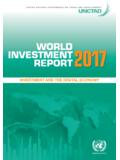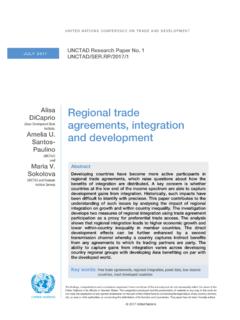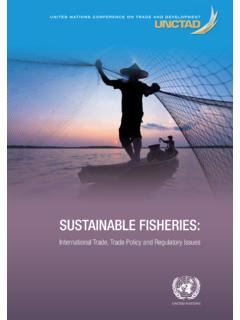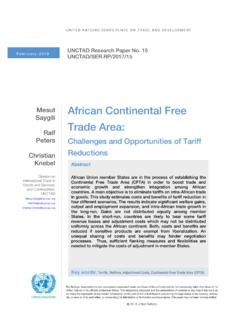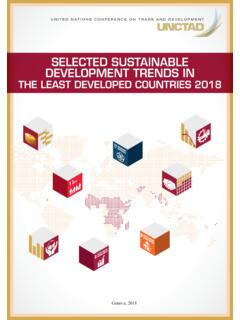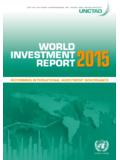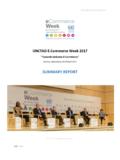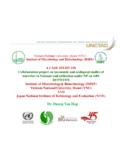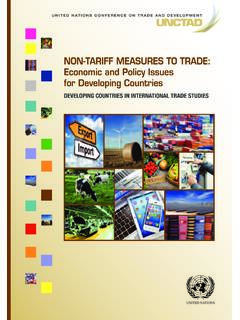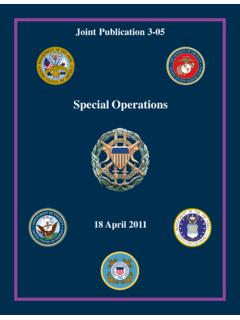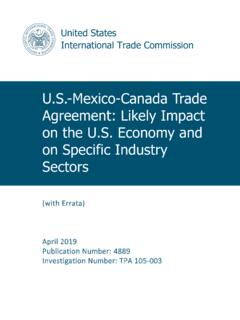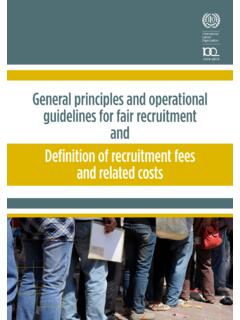Transcription of Container shipping in times of COVID-19: Why freight rates ...
1 UNITED NATIONS CONFERENCE ON TRADE AND 2021 Container shipping IN times OF COVID-19: WHY freight rates HAVE SURGED, AND IMPLICATIONS FOR POLICYMAKERSPOLICY BRIEFKey points Container freight rates have reached historical highs and rates to South America and West Africa are now higher than to any other major trade region. The obstruction of the Suez Canal by a grounded Container ship contributed to a recent further surge in freight rates . The underlying causes are complex and include capacity management by carriers and a severe shortage of containers as these are held up in waiting ships, combined with pandemic-related delays in intermodal connections. The impact of the Container shortage is greater on longer and thinner trade routes to developing regions than on the main East West routes.
2 The current surge is expected to last into 2021. In the longer term, policymakers need to focus on (a) further reforms in trade facilitation and ports; (b) improved tracking and forecasting; and (c) strengthening national competition the start of the coronavirus disease of 2019 (COVID-19) pandemic, expectations were that seaborne trade, including containerized trade, would experience a strong downturn. However, changes in consumption and shopping patterns triggered by the pandemic, including a surge in electronic commerce, as well as lockdown measures, have in fact led to increased import demand for manufactured consumer goods, a large part of which is moved in shipping containers.
3 As at the third quarter of 2020, lessening of lockdown measures and varying speeds of recovery worldwide, as well as stimulus packages supporting consumer demand, inventory-building and frontloading in anticipation of new waves of the pandemic, contributed to leading to a further increase in containerized trade This policy brief is based on UNCTAD, 2020a, Review of maritime Transport 2020 (United Nations publication, Sales No. , Geneva).Photo credit Jan HoffmannA shortage of containers and Container shipsThe increase in demand was stronger than expected and not met with a sufficient supply of shipping capacity. Empty containers to move exports from China to destinations abroad became unavailable.
4 The reasons for this shortage were the outset, the disruptions resulting from the pandemic, trade imbalances and changing trade patterns led to shifts in the geography of Container trade. Empty boxes were left in places where they were not needed, and repositioning had not been planned for. Moreover, as carriers introduced blank sailings, that is, skipped port calls, a mismatch between supply and demand for empty containers was exacerbated, as empty containers were left behind and failed to be Container crisis is also a reflection of a slowdown in and delays across the maritime supply chain due to strains caused by the pandemic, such as port labour shortages, port congestions (also due to blank sailings)
5 And capacity constraints in truck and other inland transport systems due, for example, to delays in undergoing necessary testing or delays by factories in returning containers. These factors meant that Container dwell times increased and empty containers could not return to the system in which they were most needed (UNCTAD, 2020a).Added to this is the fact that, since end-2020, Container ships have begun to anchor off the west coast of North America, waiting for berths to become free. Full containers, still containing holiday decorations in February 2021, were stuck on ships, leading to a further shortage in capacity.
6 Once containers are finally delivered and available as empty, they will be returned to China as soon as possible to be used for the next round of exports to North , the situation was further exacerbated by the obstruction of the Suez Canal by a grounded Container ship. As ships, and the containers on them, took longer to reach their destinations, the shortage of available empty boxes increased, including in Shanghai, China. As a result, freight rates increased not only on the routes passing through the Suez Canal but also on nearly all other surge in freight ratesThe trends noted above culminated in freight rates reaching historical highs by end-2020 and early in 2021.
7 The surge in freight rates spread across some developing regions such as Africa and Latin America, where it outpaced the surge observed on the main East West routes (see figure). Compared with the medians, the early-2021 peak freight rates were higher on all routes, including those depicted in the figure. In comparison, the lowest relative increase in freight rates was recorded on the Asia East Coast North America route (+63 per cent), while freight rates from China to South America were 443 per cent higher than the median for that credit Jan HoffmannWhat can explain these differences? Longer routes, including China South America and China West Africa, require more ships for a weekly service, which implies that a large number of containers are also stuck on these ships.
8 Therefore, when empty containers are scarce, an importer in Brazil or Nigeria must pay not only for the transport of the full import Container but also for the inventory holding cost of the empty there is the lack of return cargo (South America and West Africa are both net importers), which makes it costly for carriers to return empty boxes to China on long , freight rates on thinner routes, that is, with only two or three weekly services, tend to be more volatile, since taking out or adding one vessel call, or one service, makes a significant impact on the overall limited number of prevailing services, compared with on routes with a higher density and more frequent authorities in Europe and North America have closely monitored freight rates and capacity management by carriers and their alliances, possibly limiting the potential of further increases.
9 In developing countries, such monitoring and subsequent consultations with carriers may be more difficult to conduct, as national competition authorities often have limited resources and expertise in the specialized field of international Container UNCTAD, 2020b, Ten-point plan to bolster global transport, ease trade during COVID-19, 27 April, available at (accessed 14 April 2021).3 See, for example, See UNCTAD, 2019, Digitalization in maritime transport: Ensuring opportunities for development, Policy brief No. for policymakersCarriers, ports and shippers were all taken by surprise by the pandemic, and the subsequent shortage of empty containers observed since late-2020 is unprecedented.
10 No contingency plans were in place to pre-empt the lack of availability or to mitigate its negative impacts. Given current trends, several months will likely pass before this disruption can be absorbed across the maritime supply chain and before the system resumes smoother operations. In the meantime, there are three key considerations for policymakers, to help reduce the likelihood that similar situations will occur in the facilitation and digitalization for resilient supply chains. The pandemic has highlighted the importance of resilient supply chains. Customs officials, port workers and transport operators have recognized the need to reduce physical contact, while at the same time keeping ships moving, ports open and cross-border trade Some of the trade facilitation solutions proposed by UNCTAD contribute to achieving the objective of facilitating trade and transport while at the same time protecting the population from the Many of the measures depend on the digitalization of trade procedures, including in maritime UNCTAD has embarked on a fast-track technical assistance project aimed Abbreviations: FEU, 40-foot equivalent unit.
